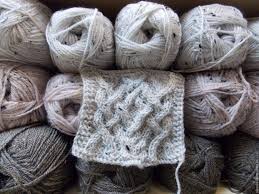Craft stores offer many different types of yarn. You can choose plain or variegated, wool or acrylic, traditional or fancy. Among this wealth of assortment there is tweed yarn. Read on to find out what it is, its history and secrets.
What kind of yarn is tweed?
 In the mountainous regions of Scotland, since the early Middle Ages, a thick, warm, wear-resistant fabric called tweed was produced from coarse sheep's wool. Simple and rough clothes were made from it, which could protect a man from the piercing wind and incessant rain. Highlanders wore tweed raincoats, using them as shelter from bad weather, blankets for sleeping, and blankets for horses. The pure wool fabric warmed both the rider and the horse.
In the mountainous regions of Scotland, since the early Middle Ages, a thick, warm, wear-resistant fabric called tweed was produced from coarse sheep's wool. Simple and rough clothes were made from it, which could protect a man from the piercing wind and incessant rain. Highlanders wore tweed raincoats, using them as shelter from bad weather, blankets for sleeping, and blankets for horses. The pure wool fabric warmed both the rider and the horse.
From constant wear, the surface of the fabric became covered with a layer of fat, which repelled water. The result was waterproof, warm clothing made from natural wool that retained its quality for a long time.. At first it was hard and prickly, but under the influence of moisture it softened. Tweed was dyed with natural dyes, including lichens, heather, and various grasses. They produced very durable, but faded and inexpressive colors. Not only commoners, but also men of noble families used such clothing to insulate themselves.
Clothes were woven from coarse wool; the thread often contained inclusions of a thicker structure, undyed or multi-colored areas. Over time, the technology for producing threads and yarn has changed, but its distinctive features have remained unchanged.
Composition and characteristics
 Modern tweed yarn looks exactly like this - with thickenings and islands of heterogeneity. It retains a dull color and can contain not only sheep, but also other types of wool, as well as cotton and synthetic materials. Thickenings may be rare or frequent. Light yarn usually has dark inclusions, while dark yarn has light inclusions.
Modern tweed yarn looks exactly like this - with thickenings and islands of heterogeneity. It retains a dull color and can contain not only sheep, but also other types of wool, as well as cotton and synthetic materials. Thickenings may be rare or frequent. Light yarn usually has dark inclusions, while dark yarn has light inclusions.
Advantages and disadvantages of threads
Tweed yarn has many advantages:
- even the simplest model of these threads looks stylish and impressive;
- it is recommended for beginner needlewomen, since on a fabric with a non-uniform structure, unevenly knitted loops are not visible;
- the yarn holds its shape perfectly, you can knit various elastic bands, braids, aranas;
- This is a very economical option for hand knitting warm clothes. For a standard sweater made from plain tweed, you will need 1.5 times less than regular wool.
Like any other material, tweed yarn has its disadvantages:
 in the finished product it tingles slightly;
in the finished product it tingles slightly;- shrinks in length.This feature is taken into account by craftswomen who knit items from the neck down, intending to knit the missing number of centimeters during operation;
- When working with knitting needles, the fabric may become skewed, which is corrected using false crocheted seams.
Important! When knitting any item made from tweed wool, the loops should be loose and the fabric should be loose. During the first wash, the wool fibers swell and fluff slightly, the loop structure becomes dense, and the finished product softens.
What is knitted from tweed wool?
Typically, such yarn, which is not gentle on the body, is used for knitting warm outerwear and other clothing, it can be:
 cardigan or jacket;
cardigan or jacket;- sweater;
- tunic or dress;
- scarf;
- hat or cap;
- skirt;
- jacket;
- coat.
Important! Before starting work, be sure to knit a sample and make sure that the chosen braid or aran pattern will not be blurred by the structure of the yarn.
How to care for a tweed item?
Caring for tweed - washing, drying, storing - is simple. It is important to follow the recommendations of professionals, and things made from this yarn will warm and delight you for a long time:
- hand wash - in warm water with special liquid products;
- push-ups - using a dry towel;
- drying - only on a flat horizontal surface;
- storage - on a shelf, not on a hanger.
Important! Avoid heat treatment of products made from tweed yarn; ironing will lead to stretching and loss of elasticity of the threads.


 in the finished product it tingles slightly;
in the finished product it tingles slightly; cardigan or jacket;
cardigan or jacket; 0
0





